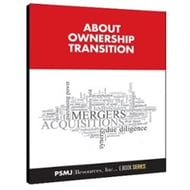Generational forces at work in today’s architecture or engineering firm present a major challenge to effective ownership transition. Thus, as a firm leader, you must do more than consider new or revised terms in your buy-sell agreements.
Today’s Perfect Storm. Internal ownership transition has gotten to be one of the most difficult challenges facing A/E firm leaders today. In fact, we have just run into what could be called the “perfect storm.”
The number of Baby Boomers who own equity in the A/E industry and want to get out is at an all-time high. It is going to get higher yet, but it is peaking with the current demographic of firm owners.
While current Boomers are looking to retire, however, few Generation Xers are ready to take over the reins, and the following generation (i.e. Millennials) have different expectations. And, many of these younger folks coming up the line are still shell-shocked from the recession. They saw themselves and all their friends get laid off. They expect to be given the ownership, that, in effect, they have already learned it by being a good employee.
Because of a reduced demand for shares inside the firm, there are not a lot of buyers out there for internal ownership. And, of course, this doesn’t fit with the retirement plans of the Baby Boomers, many of whom are behind schedule because of the losses they incurred during the recession. And so, when you combine a pressure for value with the fact that the younger folks don’t want to pay, the result is nothing less than a logjam.
Firm leaders, however, should not assume that an external sale is always a good “fallback” position. There’s a good chance that the younger folks would not come along in a sale. For sellers to be able to deliver firm value, they have to be able to bring their key staff with them. And so, the process is circular: It runs right back into itself.
To say it another way, retiring Baby Boomers must consider how an external sell would impact firm culture. Moving from an internal to external sale greatly increases the influence of money on your decision. The middle management does not get it: They joined and stayed at the firm because of the way it operates.
Financial Planning for Ownership Transition. Many firms want to stay independent. Their owners say: “I don’t want to or I don’t think I could sell to an outside firm, and I don’t want to stick around here very much longer. I have to do whatever it takes to make this go.” And so, in order to induce the younger folks to
buy, buy/sell agreements are becoming much more negotiated in the favor of the buyer. This includes much more financial assistance to the buyers, reductions in valuations for the firm for internal transition, and less-restrictive non-compete clauses.
The other thing firms are doing in the good economy right now is finding ways to maximize profits, and then increase the distribution to the owners as much as possible. If you can absorb the discount to keep the firm independent and give it to the next generation—and you can sell it at a value they are willing to accept—that’s great. Firms interested in staying independent in this way need to begin planning at least 10 years in advance.
Time to Invest in Young Entrepreneurs. We also find that firm owners often turn to an outside sale as a fallback position because they have not done any leadership development or mentoring. In about 4 out of 5 assignments that we do, the owner wants to sell internally, and finds out that he can’t. So if you’re considering an internal sale, start by investing in your younger employees now. Grab your top two entrepreneurs and train them up. This means investing in your people even before you consider an ownership transition.
If you want to have the choice of selling internally, you need to grab people early in their career and invest in them. Find someone you know who has six to eight years before they’re ready for ownership. Provide them with management and business training. And make sure they understand all of the services you offer and all of the types of clients you serve. The goal is to give them a broad base of experience, and not let them get pigeon-holed.
It is by sharing information with your entrepreneurs—showing them the way the firm operates, how much money it makes, and how much money it costs to keep the place open—that you begin to generate an ownership mentality. This should be job number one or you are not going to get out the way that you want to. You are multiplying your choices the more time you spend with your young entrepreneurs.
Then, if they choose—their eyes are completely open and they have complete understanding of the challenge, that’s great. And if they choose not to buy—because they don’t want it or their situation doesn’t allow—then you have the opportunity to say: “We gave you the chance. Now we have to sell externally because I am 65 and not getting any younger, so are you sure?”
 PSMJ's complimentary e-book About Ownership Transition goes into real tangible insight and advice on:
PSMJ's complimentary e-book About Ownership Transition goes into real tangible insight and advice on:
-
How to start planning for transition on the day you start your firm
-
An understanding of how transition effects every management decision you make
-
Common pitfalls in the transition process and how to avoid them
-
How to keep your architecture or engineering firm focused on its vision through a transition
You also might be interested in these ownership transition related blog posts:
Changing Expectations of Firm Ownership
How to Get Millennials to Buy In to Firm Ownership
What Potential Firm Owners Need to Know
How the Age Bubble Is Transforming the Workplace—and What You Can Do to Prepare




